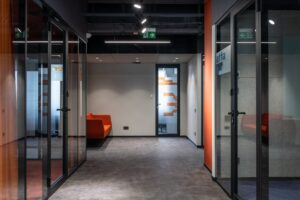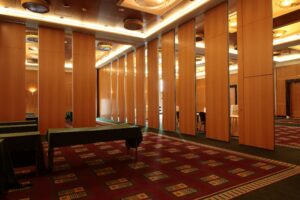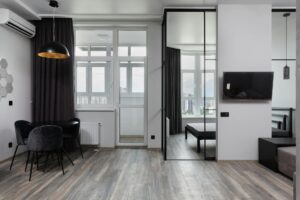Operable walls and partition systems are innovative solutions for creating flexible and adaptable spaces. They go beyond the limitations of traditional fixed walls, offering a dynamic way to transform an environment to suit different needs. This comprehensive guide dives deep into the world of operable walls, exploring their functionality, applications, and the numerous benefits they provide.
Defining Operable Walls and Partition Systems
An operable wall, also known as a movable wall or a partition system, is a series of interconnected panels that can be easily opened, closed, or reconfigured to create or divide spaces. Unlike permanent walls, operable walls offer the advantage of adjustability, allowing for on-demand changes in room size and functionality.
These systems typically consist of individual panels that run along a track mounted on the ceiling, floor, or wall. The panels can slide, fold, accordion, or pivot depending on the specific design. When closed, they create a soundproof and visually separated space, similar to a traditional wall. However, when opened or reconfigured, they can transform the layout entirely, offering an open and flexible environment.
Partition systems, on the other hand, can be a broader term encompassing operable walls but also including non-movable partitions. These may be fixed panels that offer some level of space division but lack the adjustability of operable walls.
Benefits of Using Operable Walls
Operable walls offer a multitude of benefits for various applications. Here are some key advantages to consider:
- Space Optimization: Operable walls allow you to maximize the use of your available space. By creating or merging rooms on demand, you can adapt the environment to accommodate different activities and user groups.
- Flexibility: Operable walls provide unmatched flexibility. Need a large conference room for a presentation in the morning and smaller breakout spaces for group discussions later in the day? Operable walls can help you achieve this seamlessly.
- Improved Acoustics: Certain operable walls are designed with soundproofing features, allowing you to create quieter and more focused environments. This is particularly beneficial for offices, classrooms, and healthcare facilities.
- Privacy Control: When closed, operable walls provide a high degree of privacy, ideal for meetings, confidential discussions, or individual workspaces.
- Enhanced Aesthetics: Operable walls come in a variety of finishes, materials, and even glass options. They can add a modern and sophisticated touch to any space while remaining functional.
- Natural Light Control: Operable walls with glass panels allow for natural light penetration, even when a room is divided. This can create a more pleasant and energy-efficient environment.
- Cost-Effective: While the initial investment for operable walls might be higher than traditional walls, the long-term benefits outweigh the cost. The flexibility and space optimization they offer can lead to increased efficiency and productivity, ultimately saving money.
Types of Operable Walls and Partition Systems
Operable walls come in a variety of styles and configurations, each suited for specific needs and applications. Here’s a breakdown of some common types:
- Sliding Operable Walls: These consist of individual panels that slide horizontally along a track on the ceiling or floor. They offer a simple and efficient way to divide or open a space.
- Folding Operable Walls: These walls feature accordion-style panels that fold and stack neatly when opened, providing a space-saving solution.
- Telescoping Operable Walls: These walls consist of nested panels that extend or retract to create or divide space. They are particularly useful for situations where storage space is limited.
- Pivot Operable Walls: These walls have panels that pivot on hinges, allowing them to swing open or closed. They offer a unique aesthetic and can be used to create angled configurations.
- Glass Operable Walls: These walls utilize transparent or translucent glass panels, allowing for natural light penetration while still providing some level of space definition.
- Acoustical Operable Walls: These walls are specifically designed with soundproofing materials to create soundproof barriers between spaces. They are ideal for applications where noise control is crucial.
Applications of Operable Walls and Partition Systems
Operable walls offer a versatile solution for a wide range of applications. Here are some examples of where they are commonly used:
- Offices: Operable walls are ideal for creating flexible workspaces. They can be used to define individual office spaces, create collaborative meeting areas, or separate large open areas into smaller, more focused work zones.
- Educational Institutions: Operable walls are valuable assets in schools and universities. They allow for the creation of flexible learning environments, dividing large classrooms into breakout spaces or separating noisy activities.
- Hotels and Convention Centers: Operable walls can transform large ballrooms into smaller meeting rooms or banquet halls. They offer the flexibility to accommodate various event sizes and needs.
- Healthcare Facilities: Operable walls can create private patient rooms,




